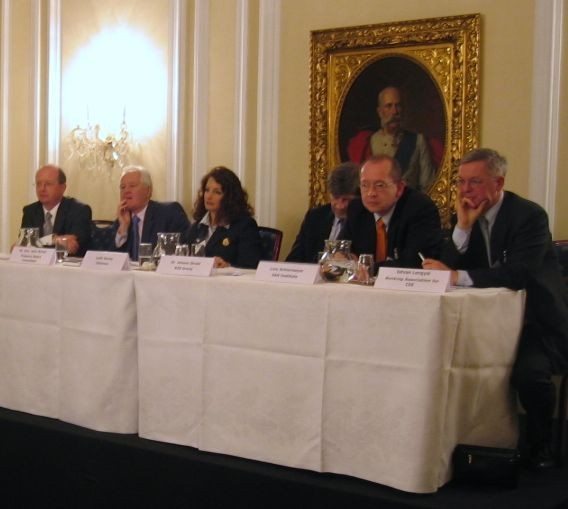
We had our final meeting of the year for the Financial Services Club in
Central & Eastern Europe (FSClub CEE) this week, with an excellent
panel discussion about the risks and opportunities across the region
looking forward. This is almost a bookend to our opening FSClub CEE discussion of whether there was a credit crisis in the region, which there definitely is.

The panel comprised (from left to right):
- Franz Reif, Head of Strategic Risk Management, Volksbank Group;
- John McFall, Chairman of the House of Commons Treasury Select Committee;
- Lydia Goutas, co-Chair of the FSClub CEE;
- Johann Strobl, Chief Risk Officer and member of the Managing Board, RZB Group;
- Lutz Schiermeyer, EMEA Head of Banking Risk BD, Global Risk Team, SAS institute; and
- Istvan Lengyel, Head of the Banking Association for Central and Eastern Europe.
I’ve decided to blog about this in three parts, with the first
part providing the dialogue between our CEE colleagues. The second part will focus upon John McFall’s comments
as they were quite UK centric; and the third part will summarise the
question I was asked: what do you think are the key risks and opportunities. That one will be posted on Monday.
So here is Part One, which covers the gist of the debate about CEE risks and opportunities (loosely written, so none of this should be taken as direct quotation).
To begin with, Lydia asked the panellists how they see the lay of the land for next year in CEE.
Johann Strobl: Well, all of our research people are optimistic about the CEE economies. They see that growth is there again in most countries, and we can be optimistic for the next three to four quarters out. This is important for the people of these countries, as they are now more optimistic as consumers and workers. For the banks there are still some concerns, and the banks will still suffer losses next year as they did this year.
Franz Reif: Austrian banks have invested heavily in CEE countries and over a long time. During this time, we did not see any defaults in the customer base on our lending, and it was seen therefore as a good time to extend our risk policies into new areas and sectors. But now we see the risks in our portfolio going down and a rise in our non-performing loan (NPL) ratios. We are now faced with fact that we need better risk monitoring and structuring and an improved credit risk process, which is not well known in these countries over the past years.
Lutz Schiermeyer: When I started work in this industry back in 1987, risk mgt was all on paper-based systems. There was not technology and there was no Chief Risk Officer. The understanding of credit risk was just starting, and now market and credit risk is a known disciplined. But the issue now is that risk is not integrated. It is all performed in silos. So we have done a lot of work on credit risk management, but it is not integrated with the lines of business or the other risk disciplines. Meanwhile, regulators are ignoring the power that technology offers to better track risks. No-one is thinking about how to manage spreadsheets for example, or the associated spreadsheet risks or frauds. I know of key traders and dealers who walk around with 100 megabyte spreadsheets where they have modelled their whole portfolio analytics and trading strategies. That’s a lot of data to play around with, and it can leave the system open to significant possibilities for risk or fraud.
There’s a lot of room to improve what we are doing therefore. In particular, we need more integration of the risk management functions, and more use of technology to provide risk monitoring for the regulators.
After all, the criminals understand technology and how to use it. We all know about cybercrime and malware and Trojans, but just look how sophisticated some of the attacks are today. There was one recently where RBS Worldpay was defrauded by the use of cards in many countries all at the same day and within a very narrow time window. That just goes to show how criminals can co-ordinate globally and, using technology, their crimes can be committed very fast.
Equally, think about the film Wall Street with Michael Douglas, made back in 1987. They are making a new film for release next year, but the Wall Street of 1987 is very different to the Wall Street of 2010, especially the shift in the power and usage of technology.
So regulation should take into account the I.T., and it is a massive failure that it does not enough today.
Johann Strobl: Those who are making the rules are too driven by other bodies and pressures, and banks are too driven by analysts and investors. We must not go back to the old days where banks were very opaque. We need more transparency but with Basel II, where there is so much demand for transparency, this can be an issue.
Istvan Lengyel: The regulator is asking for more capital whilst also asking for more lending. We need balance. The markets are cyclical and the regulation we need should be to manage pro-cyclicality. Reserve in good times for the bad times.
In the EU, the issue is that different economies are at different positions in the cycle. Spain is an example. Spain had a special anti-cycle reserve requirement to allow for a period of a full cycle of market movements: not just the cycle for the last year, but how much to reserve and what capital would be required for the complete loss of assets over a full cycle from the last boom period. Typically, this demands reserves of around one to two percentage points of profits each year.
There is also a Croatian example, where banks are told to just limit credit growth to under 15% per year and, if you go above it, you are punished with much more aggressive reserve requirements. This is why Croatian banks have survived this crisis well.
Franz Reif: There is a discussion about new regulations but new regulations are interesting. They make our business far more expensive for example, and new regulations do not necessarily make our business more stable. Basel II was developed in a benign business environment, for example, and no-one knew what would happen in a downturn. So it made us go in a direction, and that direction has been very costly – we have all made significant investments in Basel II – but it was not necessarily a safer direction.
Transparency is also interesting, as this can give us an extremely good view of our competitors. Is that a good thing? Again, not necessarily as it means our competitors can get an extremely good view of us too.
Finally, we can talk about models, systems and controls with technology, but we had those. Technology is required, but it is no substitute for good decision making and good management.
Johann Strobl: A bank of any size in the EU has typically invested over €100 million each in Basel II. We have invested so much in this infrastructure that this must be recognised now we are in crisis. Basel II cannot be just replaced or thrown to one side. Rather, these systems and controls must now be aligned to look for the real numbers and real exposures in risk. That approach would be very popular.
Lydia then asked: how do we change the culture of a bank from being opportunistic to risk-based?
Johann Strobl: We saw opportunities that weren’t actually opportunities at all. What we were actually doing was just picking up money cheaply. By way of example, I asked my risk managers where the future problems would come from last year, and they thought the subprime crisis obviously, but also that M&A financing had gone too far. There was too much leverage in play. So I asked them what would be the impact on our portfolio of this, and they said none. They said we only have around €25 million of Asset-Backed Securities (ABS) on our books, and that was about it. But they forget that we are in a global situation and I forgot to ask if we don’t have the problem, who does? Or the subsequent follow-up question that should have been, if they have problems then how will that affect us. These would have been the right questions in hindsight because it would have led to a review that would have included modelling a liquidity squeeze. We will obviously now do this when this happens again.
Meanwhile, as of 2009 and 2010, we have to go back to the basics: if we lend money, we need to know when and how we will get it back.
Istvan Lengyel: Johann has identified the crux of the matter here with the view of modelling for a liquidity squeeze as even if one bank has a good risk management system, if it is not linked to other banks risk management systems then it is not robust. We therefore need macro-prudential regulation at this level in order to get a macro-risk view.
Franz Reif: Cross-selling and creating earnings from non-risk assets will also be a key. For example, we are looking at our existing portfolio of customers in order to see how we can gain more deposit based services. This will reduce risks and the CRO is a k
ey player in these decisions. That is why the role of the CRO has changed in last few years, from a functional or even sub-functional role, to being an active member of the executive steering committee.
Johann Strobl: If you want to change the culture of the bank to a risk averse one, then the CEO is the only one who can do this. It is not up to the CRO as he or she can only implement what the CEO directs. If you make financial risk a core activity rather than a by-product of banking, then it changes the game.
Chris M Skinner
Chris Skinner is best known as an independent commentator on the financial markets through his blog, TheFinanser.com, as author of the bestselling book Digital Bank, and Chair of the European networking forum the Financial Services Club. He has been voted one of the most influential people in banking by The Financial Brand (as well as one of the best blogs), a FinTech Titan (Next Bank), one of the Fintech Leaders you need to follow (City AM, Deluxe and Jax Finance), as well as one of the Top 40 most influential people in financial technology by the Wall Street Journal's Financial News. To learn more click here...


